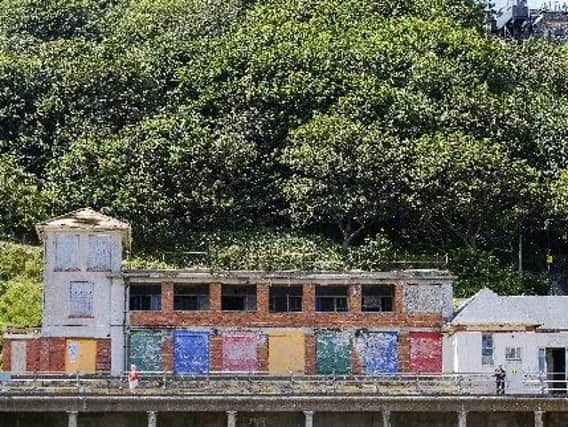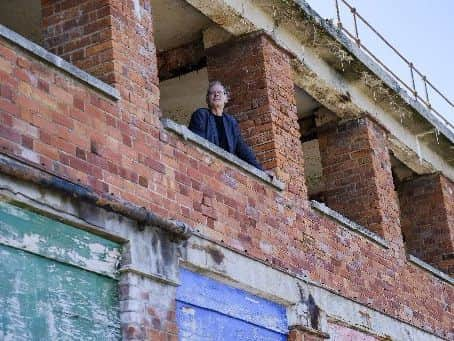Scarborough's ray of sunshine for the arts


In one of Scarborough’s most beautiful and iconic landscapes, stuffed with important buildings, there lurks a small, but noticeable, sore thumb. Walk past the Grade II listed Victorian Spa complex heading south and almost immediately, you’ll come across the funicular cliff railway, built in 1875 and thought to be the earliest such passenger railway in England – and also Grade II listed.
A little further along there are colourful beach huts dating from the early 20th century and, says Historic England, “examples of the first chalet style of terraced beach huts in England which contribute to the development of the building type”. They’re one of just two sets of listed beach huts in the whole of our seaside-centric country. And there’s more.
Advertisement
Hide AdAdvertisement
Hide AdJust above them, and a definite contender for the title of ‘café with the best view in the country’, stands the glorious Edwardian red-tiled Clock Café – again, Grade II listed. Even the gardens which meander up the cliffs behind the area are an Historic England Registered Park and Garden. And yes, for the record they are also Grade II listed.


It’s tempting, then, to see the poor unlisted, derelict little shell of a place slap bang in the middle of all this, and known locally as the sunbathing building, as a very poor relation. What’s left of the paint is chipped, most of the windows have gone and inside, well let’s just say it has seen better days.
However, all that could change if the vision of a Scarborough arts organisation is realised over the next few years. Crescent Arts aims to convert the brick and concrete-rendered building into a beachside arts resource.
It will, says director Stuart Cameron, be ‘a visual arts and creativity centre by the beach and a spectacular new home for us’. Crescent Arts is one of Scarborough’s three Arts Council England National Portfolio Organisations – the other two are the Stephen Joseph Theatre and a newcomer to the town, art-meets-science curators Invisible Dust. NPOs are those bodies which receive regular annual funding, and are seen as representing some of the best arts practice in the world.
Advertisement
Hide AdAdvertisement
Hide AdAnd yet, for the past 38 years, this nationally important cultural outfit has made its home in the basement of Scarborough Art Gallery. Even though it’s just a stone’s throw from the town centre, it’s not easy to find. And when you do it’s not exactly accessible or welcoming. A flight of steep stone steps takes you down into a mysterious subterranean warren of rooms inhabited by a gallery and seven artists’ studios. A bright and breezy new home is just what the organisation needs.


The sunbathing building stands above a colonnaded area on Scarborough’s South Bay beach known as ‘children’s corner’. It was built in the early 1920s, and comprises a two-tier row of chalets with a tower at one end and a toilet block at the other.
The tower housed the superintendent’s office – by chance, the council worker who comes to open up the building for us is the son-in-law of the last superintendent, and remembers his father-in-law sitting in the office, with its hatch overlooking the beach, dealing with chalet bookings and lost children.
The sunbathing element was the flat roof, where sun-worshippers had unimpeded access to a tan. The building was last used for its original purpose around 25 years ago – since then, it has fallen into disrepair, home only to pigeons.
Advertisement
Hide AdAdvertisement
Hide AdIf Crescent Arts get their way, the building will take on a new lease of life, offering creative activities by the beach for all ages and abilities.


“There’ll be exhibitions, workshops, film screenings, performances, talks and social events for creative rock poolers, beach combers, sand sculptors, silver surfers, and more,” Stuart says.
“Scarborough has such a vibrant creative sector with high quality cultural venues including the the Spa, the Open Air Theatre, the Stephen Joseph Theatre and the Rotunda Museum.
“But we lack the equivalent contemporary visual arts provision to meet professional and community interests. This project presents a significant opportunity for us to develop and build on over 35 years of support to artists, creative communities and the education sector.
Advertisement
Hide AdAdvertisement
Hide Ad“It will provide a stunning space for art exhibitions, events and workshops, with a range of open and inclusive cultural, leisure, educational and training activities for both residents and visitors. “The significance of arts and culture as a driver for regeneration has been an ongoing theme in Scarborough’s successful Renaissance programme and is well-evidenced in other coastal towns such as Margate.”


Crescent Arts took the innovative step of involving Project Office, a design and research collaboration of staff and students at Leeds Beckett University’s school of art, architecture and design, at a very early stage. Project Office, which specialises in ethical, social and resilient architecture, used the scheme as a start point for 20 of their students to come up with potential designs as part of the second year of their seven-year courses – there’s no guarantee that any of the resulting designs will end up in the flesh, but it’s entirely possible.
The designs ranged from the functional and utilitarian to curvaceous flights of fancy that wouldn’t have looked out of place in Zaha Hadid’s portfolio – one even proposed using the colonnade below the building (not part of the scheme) as a sound chamber.
“This has been an unusual and exciting project,” says Craig Stott, Project Office co-director, architect and senior lecturer at Leeds Beckett.
Advertisement
Hide AdAdvertisement
Hide Ad“BA architecture students from our CITYzen Agency design studio completed these architectural proposals for the reimagining of the redundant bathing huts.
“At the university our terminology for working with real clients is a ‘live project’. The range of live projects gives the client many options to consider.
“The results demonstrate the talent of young designers and how they can be a force for good in the real world. We are looking forward to the next stages of the project.”
So how long will all this take?
“How long is a piece of string?” laughs Stuart, acknowledging that the ambitious plans will take time to realise. “We’re still at the very early stages, but we’re encouraged so far that everyone we have spoken to is very positive about the idea.
Advertisement
Hide AdAdvertisement
Hide Ad“The Leeds Beckett designs were recently on display at our current venue on The Crescent – and can still be seen by appointment if anyone wants to contact me – and the response was universally enthusiastic.
“We’ve just got a grant from the Architectural Heritage Fund to support a feasibility study to find out just how much the whole thing will cost – we’re anticipating from £750,000 for the more basic version, up to perhaps £2m for everything we want.
“We should know whether we can take this all forward by the end of this year, and our current NPO funding from Arts Council England will take us through to 2022, so it would be great to see the project realised by then.”
For further information on Crescent Arts go to crescentarts.co.uk and for more details on the Leeds Beckett University school of art, architecture and design visit leedsbeckett.ac.uk.